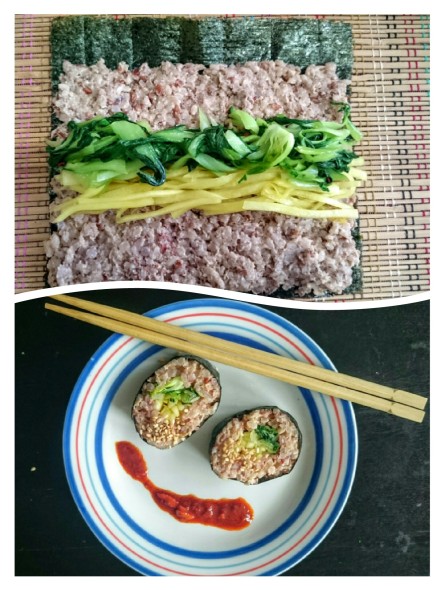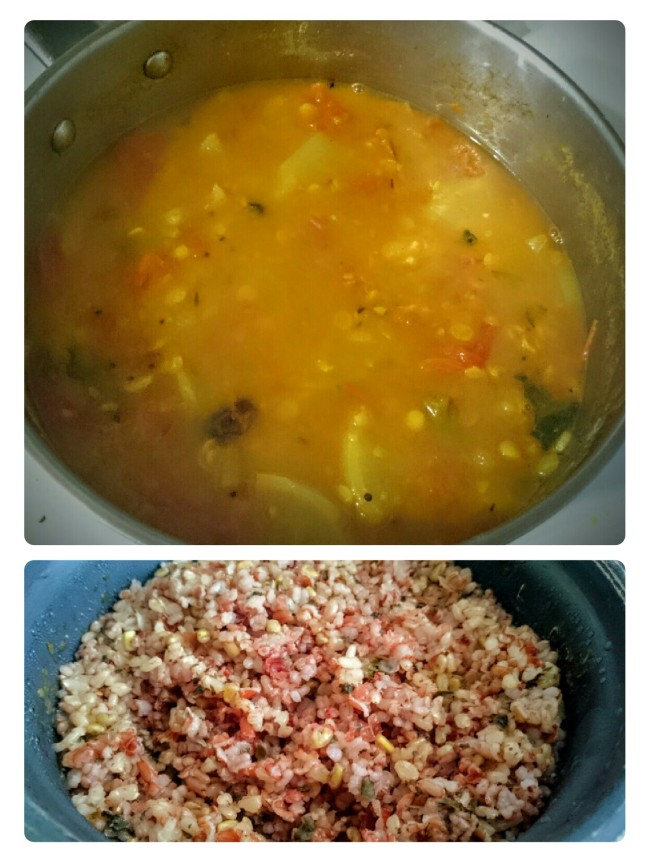
After I picked up nori roasted seaweed sheets at the Asian store, an experiment of sushi or Korean gimbap was imminent. I am still slightly wary of trying seafood here, so I decided to stick with the vegan theme.
As you would see in the recipe, I made do with the ingredients I already had, without sweating over getting too many of specialized items. So it might look like a cheat’s gimbap/ sushi to some 🙂 But I do believe that not having only one or two of ‘authentic’ ingredients should not stop you from adventures of healthy cooking from different food cultures.
VEGETABLE GIMBAP/ SUSHI
Makes about 16-20 bite-sized portions
Ingredients:
For rice–
1 cup of brown and red rice mix (my regular blend, really)
3 tbspoons of flax seed powder
2-3 tbspoons of lime juice
Dash of sesame oil
For filling–
2 to 3 inches long daikon/ radish piece
2 teaspoons of salt and 1 teaspoon of turmeric powder (gives nice colour)
1/2 cup white distilled vinegar
1/2 cup water
1 tbspoon maple syrup (can be substituted with sugar or honey)
8-10 baby bok choys
2-3 garlic cloves and chili flakes to liking for sautéing
Nori roasted seaweed sheets
Method:
- Cook the rice, as per directions. Once it is cooked, stir in flax seed powder, lime juice, and sesame oil to it and mix properly. The flax seed powder would make it ‘sticky’ and the lime juice and sesame oil would give it subtle flavor.
- Cut daikon or radish into thin narrow strips like that of matchsticks with sharp knife or mandolin slicer. Sprinkle some salt and turmeric powder over it and keep aside. After 15 minutes, drain of its liquid and rinse thoroughly.
- Meanwhile, in a saucepan bring a mix of vinegar, water, maple syrup, chilli flakes, and pinch or two of salt to boil. Strain it over the rinsed radish matchsticks. Once the whole thing cools down a bit, cover and keep it freezer for 30 minutes. This would give you quick pickled radish.
- Remove the ends of bok choy. Cut in broad strips. Sauté those in a pan over heated sesame oil, with chopped garlic and chilli flakes. Once wilted, take off the flame. Do not cover it. Otherwise it would lose its green color.
- Over a bamboo mat, spread the nori sheet. I happened to have table mats made from bamboo sticks which served the purpose. If you don’t have it,don’t lose your calm. Take a leaf out of Minimalist Baker‘s book and use a clean kitchen towel. Told ya…
- Over the nori sheet, spread a thin but uniform layer of rice. Leave a space of 1 inch at the end. Arrange your fillings in consecutive rows.
- Then slowly, start rolling the gimbap/ sushi away from you. Keep your thumbs under the mat to support the base. Use remaining fingers to keep fillings in place. Roll over till the nori edge reaches under the sushi. Apply a gentle pressure with both hands to shape the roll. Get the roll on a board and slice into bite-sized portions.
The sauce that you see in the picture above, I made just by blending some chili flakes, garlic, sesame oil, salt, and cranberry juice together. You can do even without it because of pickled radish and lime-seasoned rice.
 Browsing through an Asian store, we picked up a daikon, which I would soon experiment with pickling. Before that though, it had to satiate a craving for both my husband and me. Both of us like when white radishes are stewed in with daals or lentils. I even love when it is added to the fish stew that my mother makes of “
Browsing through an Asian store, we picked up a daikon, which I would soon experiment with pickling. Before that though, it had to satiate a craving for both my husband and me. Both of us like when white radishes are stewed in with daals or lentils. I even love when it is added to the fish stew that my mother makes of “